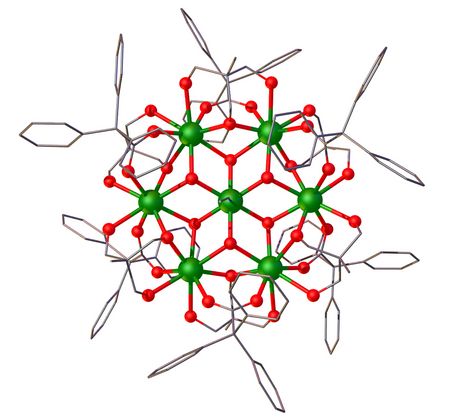MATERIALS SCIENCE AND CHEMISTRY
Finite-Temperature Lanczos Simulations of Magnetic Molecules
Principal Investigator:
Jürgen Schnack
Affiliation:
Fakultät für Physik, Universität Bielefeld (Germany)
Local Project ID:
pr63fa
HPC Platform used:
SuperMUC of LRZ
Date published:
Magnetic molecules, which form solid chemical substances, contain chemical elements that behave magnetically in the same way compass needles do. In physics, such elementary compass needles are termed magnetic moments. Within a molecule or between molecules these magnetic moments can interact. If they like to align along one common direction, the interaction is called ferromagnetic, and such a substance may form a ferromagnet such as those everybody knows. The opposite is the antiferromagnetic interaction, which forces magnetic moments into pairwise opposite directions (if possible). The group of Prof. Schnack tries to understand the magnetic properties of various molecules starting from assumptions about their pairwise interactions.
The key problem, and the reason why supercomputers come into play, results from the quantum nature of the elementary magnetic moments. Each model of magnetic moments and interactions is represented by a square matrix, i.e. a M by M table of numbers, whose eigenvalues have to be determined. The size M of such a matrix grows exponentially with the number of participating magnetic moments. Nowadays we can determine eigenvalues of matrices with sizes of about 100,000 times 100,000 with supercomputers. What sounds large is actually small in number of magnetic moments: this huge matrix size corresponds to only 17 elementary magnetic moments. Many interesting magnetic molecules require much bigger matrix sizes.
Fortunately, a powerful approximation was developed in the mid 1990s: the finite-temperature Lanczos method, which builds on a method originally developed by Cornelius Lanczos already in the 1950s. Schnack’s group employs this method to tackle problems for matrices that are 10,000,000,000 times 10,000,000,000 big. The approximation can be calculated by distributing the numerical work over several hundreds or thousands of cores of LRZ’s SuperMUC in Garching/Munich. As a result, one obtains how the magnetic properties of the considered molecule behave at certain temperatures and applied magnetic fields.

Among many interesting problems that are studied in Schnack’s group, the problem of magnetic cooling might be fascinating to everyone. When a magnetic substance is subject to a varying magnetic field, the substance can change its temperature. This is called the magnetocaloric effect; it has been used for sub-Kelvin cooling since the 1930s and for ordinary room-temperature cooling during the past 25 years. In order to optimize sub-Kelvin cooling, magnetic molecules are designed and investigated in interdisciplinary groups of chemists and physicists.
The group of Prof. Schnack performs the demanding quantum calculations in order to understand how a molecule would perform as a refrigerant material. A nice result could be achieved with a magnetic molecule containing seven gadolinium ions (and therefore abbreviated Gd7), which reached a temperature of 200 mK during a field sweep. Research along these lines is presently continued all over the world.
Reference:
J.W. Sharples, D. Collison, E.J.L. McInnes, J. Schnack, E. Palacios, M. Evangelisti, Quantum signatures of a molecular nanomagnet in direct magnetocaloric measurements, Nature Communications 5 (2014) 5321 Link
Scientific Contact:
Prof. Dr. Jürgen Schnack
Universität Bielefeld, Fakultät für Physik
Postfach 100131, D-33501 Bielefeld (Germany)
email: jschnack [@] uni-bielefeld.de
http://obelix.physik.uni-bielefeld.de/~schnack/
September 2016